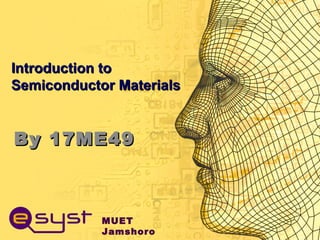
Introduction semi materials-rev7-22
- 1. MUET Jamshoro Introduction toIntroduction to Semiconductor MaterialsSemiconductor Materials By 17ME49By 17ME49
- 2. A presentation of eSyst.org Electronic MaterialsElectronic Materials • The goal of electronic materials is to control the flow of an electrical current. • Electronic materials include: 1. Conductors: have low resistance which allows electrical current flow 2. Insulators: have high resistance which suppresses electrical current flow 3. Semiconductors: can allow or suppress electrical current flow
- 3. A presentation of eSyst.org ConductorsConductors • Good conductors have low resistance so electrons flow through them with ease. • Best element conductors include: – Copper, silver, gold, aluminum, & nickel • Alloys are also good conductors: – Brass & steel • Good conductors can also be liquid: – Salt water
- 4. A presentation of eSyst.org Conductor Atomic StructureConductor Atomic Structure • The atomic structure of good conductors usually includes only one electron in their outer shell. – It is called a valence electron. – It is easily striped from the atom, producing current flow. Copper Atom
- 5. A presentation of eSyst.org InsulatorsInsulators • Insulators have a high resistance so current does not flow in them. • Good insulators include: – Glass, ceramic, plastics, & wood • Most insulators are compounds of several elements. • The atoms are tightly bound to one another so electrons are difficult to strip away for current flow.
- 6. A presentation of eSyst.org SemiconductorsSemiconductors • Semiconductors are materials that essentially can be conditioned to act as good conductors, or good insulators, or any thing in between. • Common elements such as carbon, silicon, and germanium are semiconductors. • Silicon is the best and most widely used semiconductor.
- 7. A presentation of eSyst.org Semiconductor Valence OrbitSemiconductor Valence Orbit • The main characteristic of a semiconductor element is that it has four electrons in its outer or valence orbit.
- 8. A presentation of eSyst.org Semiconductors can be InsulatorsSemiconductors can be Insulators • If the material is pure semiconductor material like silicon, the crystal lattice structure forms an excellent insulator since all the atoms are bound to one another and are not free for current flow. • Good insulating semiconductor material is referred to as intrinsic. • Since the outer valence electrons of each atom are tightly bound together with one another, the electrons are difficult to dislodge for current flow. • Silicon in this form is a great insulator. • Semiconductor material is often used as an insulator.
- 9. A presentation of eSyst.org Semiconductors can be ConductorsSemiconductors can be Conductors • An impurity, or element like arsenic, has 5 valence electrons. • Adding arsenic (doping) will allow four of the arsenic valence electrons to bond with the neighboring silicon atoms. • The one electron left over for each arsenic atom becomes available to conduct current flow.
- 10. A presentation of eSyst.org Types of Semiconductor MaterialsTypes of Semiconductor Materials • The silicon doped with extra electrons is called an “N type” semiconductor. – “N” is for negative, which is the charge of an electron. • Silicon doped with material missing electrons that produce locations called holes is called “P type” semiconductor. – “P” is for positive, which is the charge of a hole.
- 11. A presentation of eSyst.org Current Flow in N-type SemiconductorsCurrent Flow in N-type Semiconductors • The DC voltage source has a positive terminal that attracts the free electrons in the semiconductor and pulls them away from their atoms leaving the atoms charged positively. • Electrons from the negative terminal of the supply enter the semiconductor material and are attracted by the positive charge of the atoms missing one of their electrons. • Current (electrons) flows from the positive terminal to the negative terminal.
- 12. A presentation of eSyst.org Current Flow in P-type SemiconductorsCurrent Flow in P-type Semiconductors • Electrons from the negative supply terminal are attracted to the positive holes and fill them. • The positive terminal of the supply pulls the electrons from the holes leaving the holes to attract more electrons. • Current (electrons) flows from the negative terminal to the positive terminal. • Inside the semiconductor current flow is actually by the movement of the holes from positive to negative.
- 13. A presentation of eSyst.org In SummaryIn Summary • In its pure state, semiconductor material is an excellent insulator. • The commonly used semiconductor material is silicon. • Semiconductor materials can be doped with other atoms to add or subtract electrons. • An N-type semiconductor material has extra electrons. • A P-type semiconductor material has a shortage of electrons with vacancies called holes. • The heavier the doping, the greater the conductivity or the lower the resistance. • By controlling the doping of silicon the semiconductor material can be made as conductive as desired.